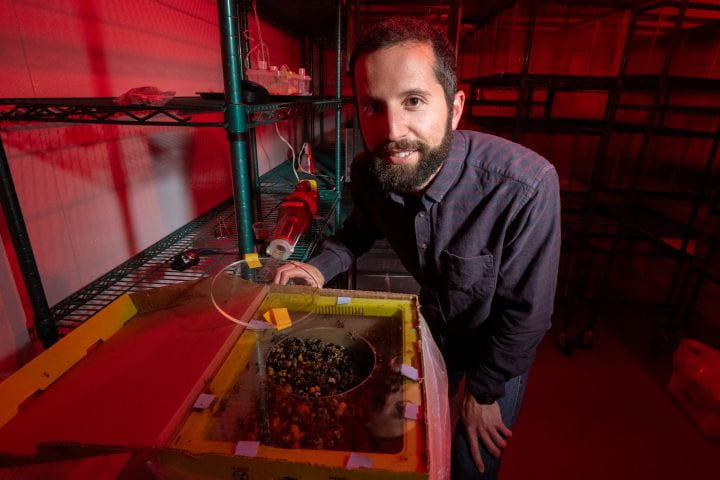August 14, 2023
The secret life of bumblebees
UC Irvine scientist uncovers surprising facts about the fuzzy insects
By Roy Rivenburg, UCI

Share
Share on TwitterShare on FacebookShare on LinkedInShare on Email
Bees that build microbreweries, ride a miniature merry-go-round and possibly even wear diapers. In biologist Tobin Hammer’s UC Irvine lab, all sorts of unusual projects unfold.
Equipped with butterfly nets and retooled hand-held vacuums, Hammer and his team corral the insects, track their behavior and study their microbiomes – the bacteria and viruses inside the bees’ guts.
The goal is to improve the health of not only wild bees but also humans, whose microbiomes are somewhat similar, says Hammer, an assistant professor of ecology and evolutionary biology.
Unlike honeybees, which have been extensively researched, bumblebees and solitary bees are largely a mystery. “We know very little about most bees,” says Hammer, who notes that roughly 70 percent of the world’s 20,000 species live underground and very few make honey.
One type brews a beer-scented liquid from fermented pollen and agave nectar. But the species is elusive, partly because it forages in the dark, usually around dawn. “I spent two months in Costa Rica looking for that bee and never found one,” Hammer says. But when several nests turned up near an Arizona ghost town, he and a cadre of scientists swooped in to round up captives and examine their subterranean habitats. In April, they published a paper on the “bee breweries.”
Hammer didn’t set out to be an insect scholar.
Growing up near Redding, California, he wanted to study lions in the wild. But in grad school, Hammer got into bugs, hosting “Moth Mania” exhibits in Colorado and displaying hissing cockroaches and metallic green sweat bees at a Texas rodeo. He also analyzed caterpillar innards and co-authored a study showing that feeding antibiotics to cows doubled their output of methane.
At UCI, Hammer explores bumblebee biology with sophisticated DNA sequencing equipment and various odd contraptions. A tiny carousel in which the insects are tethered to a rotating central column is used to measure flight speed and distance. Another device tracks social interactions via QR codes attached to each bee’s back.
A tank of carbon dioxide is used to knock out the critters before setting up experiments or transferring them to a climate-controlled chamber that formerly housed snakes. Red lights illuminate the room because the color hampers bumblebee vision, making stings and escapes less likely.
The fuzzy, yellow-and-black creatures come to UC Irvine from companies that raise bugs for farmers.
And they’re great icebreakers.
“If I tell anyone I work with bees, they’re always excited,” Hammer says. Sometimes too excited. His office is loaded with bee-themed magnets, mugs, stickers and other gifts. “The biggest problem, though, is all the puns” that people hurl his way, he says.
Hammer’s research is full of curious footnotes. As an undergrad at UC San Diego, he trained honeybees to stick out their tongues for a study that revealed they could distinguish between hot and cold foods. Later, as a postdoc at the University of Texas in Austin, he learned that the honey produced by campus bees tasted like Dr Pepper and bubblegum because the swarms often raided trash cans for nourishment.
Perhaps his quirkiest project, announced last year, is trying to design a bumblebee diaper. If successful, it would enable his team to sample gut microbiomes without having to kill any bees. When Hammer briefly mentioned the idea during a presentation to UC Irvine scientists, “the diaper was all they wanted to talk about afterward,” he says.
For now, however, the proposal is mostly fanciful. Even if a prototype is developed, how would researchers attach it to a bee’s bottom? “That’s the million-dollar question,” Hammer acknowledges. “We need someone who’s good at arts and crafts.”
A bee laxative may also be essential. “It’s really hard to get them to poop,” he says. “We’ve tried feeding them different concentrations of sucrose,” but no magic formula has emerged.
As offbeat as such research may sound, there’s a serious purpose behind it. Wild bees are imperiled, Hammer says, and some efforts to help are having the opposite effect.
“Everyone wants to ‘save the bees,’ but that usually means honeybees, which aren’t in danger of going extinct,” he explains. Moreover, honeybees compete for food with their outnumbered cousins and can also spread diseases to them, Hammer says.
To protect wild pollinators, he suggests planting more flowers, using fewer pesticides and creating nesting habitats in yards – patches of diggable dirt and homemade or store-bought “bee hotels,” the insect equivalent of birdhouses.
Meanwhile, back in the lab, Hammer and his team are working on everything from glow-in-the-dark gut bacteria (for easier microbiome studies) to bumblebee probiotics (for improved insect health). The latter might even boost resistance to pathogens. There’s just one hang-up, Hammer says: “How do you make a bee take a probiotic?”
If you want to learn more about supporting this or other activities at UCI, please visit the Brilliant Future website athttps://brilliantfuture.uci.edu. Publicly launched on Oct. 4, 2019, the Brilliant Future campaign aims to raise awareness and support for UCI. The Charlie Dunlop School of Biological Sciences plays a vital role in the success of the campaign. Learn more by visiting https://brilliantfuture.uci.edu/school-of-biological-sciences/.

